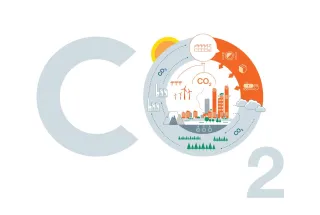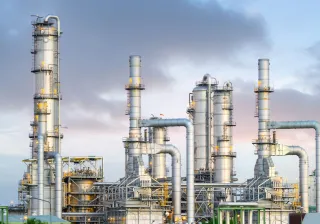Carbon capture and utilization (CCU) technologies have an enormous potential in reducing the environmental impacts and mitigating the climate change, however applied alone, these technologies do not have the capacity to solve the climate crisis. From a climate change mitigation perspective, avoidance and reduction of the current emissions should be a priority, while simultaneously directing focus on developing solutions to current challenges for which CCU and CCS technologies and their combination can be a tangible solution alongside other technologies.
The IPCC’s Special Report on Global Warming of 1.5°C calls for urgent actions to mitigate the worst consequences of the climate change by maintaining the global temperature increase below 1.5°C. There is still an opportunity for inhibiting further increase of the global temperature, but the window is closing and succeeding in the goal requires rapid measures all around the world such as the increase of the energy intensity in the production, enhancing circular economy, transition to emission free energy and sustainable food production.
Carbon capture and utilization (CCU) and carbon capture and storage (CCS) technologies are perceived as promising solutions in mitigating the climate change and reducing the environmental impacts. CCU technologies focus on the utilization of the CO2 as a raw material, for instance, by replacing the fossil and biogenic raw materials in the production. CCS technologies, in turn, capture and sequester carbon dioxide on a long-term and permanent basis, for example in the soil and seabed, to prevent recovered CO2 from escaping into the atmosphere. There is also possibility to deploy a combination of these technologies referred to as carbon capture and utilization and storage (CCUS).
BECCU project’s CCU concept for the production of polyols
CCU technologies can be deployed for many different purposes, and one of these pathways is the production of various specialty chemicals, fuels, and polyols from the recovered CO2. In the BECCU project funded by Business Finland, VTT and a group of Finnish companies are researching and developing the recovery of biogenic CO2 and its use in the manufacture of specialty chemicals, which are needed in the production of (polycarbonate) polyols. Polycarbonate polyols, in turn, are used in the manufacture of various polyurethanes, such as adhesives, building insulation boards and goods (e.g., shoes and mattresses).
The solution of the BECCU (Bio-Energy with Carbon Capture and Utilization) concept is based on the use of CO2 as a raw material in the production of polyols. The solution is expected to reduce the environmental impacts of the processes, while gaining superior product properties (which may exceed those of conventional polyols); in addition, a variety of other potential benefits are studied as part of the research.
The polycarbonate polyol produced applying the BECCU concept aims at replacing (to a certain extent) the traditional polyether polyol made from fossil raw materials. Currently, there exists a commercialized route for polyether polyol production with lower emissions, in which approximately 30% of the carbon content of the polyol is sourced from the recovered CO2. In this route CO2 is used at the end of the polyol production process (i.e., CO2 added during the polymerization step). Whereas, in the BECCU concept, all the needed carbon to produce the polyol is obtained from the captured CO2, which is used both in the production of the specialty chemicals and the polymerization stage of the polyol.

The challenges of the environmental sustainability assessments of the CCU technologies
Studies have shown that the use of CO2 as a raw material in the production of polyols, in this case polyether carbonate polyols, reduces both the CO2 emissions of the product and the use of fossil raw materials in the production. Compared to the conventional production route, the CCU route leads to better results in environmental performance.
On the other hand, the CCU technologies are still at early stage, which bring uncertainties to their environmental assessments. Life cycle assessment (LCA) is one of the most widely used environmental assessment methods, which is applied also in the evaluations of the CCU technologies. Life cycle assessments form an understanding of the environmental impact of a produced product or service. However, the application of LCA in the evaluations of the CCU technologies is not an established practice yet, which has consequently led to divergent results in the assessments of the same CCU technology making the results unreliable. In particular, the inclusion of the original point source of the CO2 in the calculations plays an important role, as do a number of other decisions that affect the outcome of environmental assessments. The challenge is recognized within the scientific community and is being addressed, for instance by the CO2 initiative operating in the University of Michigan with the goal of bringing together the scientists and specialists around the globe to unify the application of the methodology and ease the decision-making related to the life cycle assessments of the CCU technologies.
It is crucial to compare the environmental impacts of the CCU, CCS and CCUS technologies of different types, and understand their sustainability performance, especially when they are valued against the traditional and prevailing options. Comprehending the differences between the existing and emerging solutions as accurately as possible enable more accurate measurements. Improper environmental assessments can lead to misjudgement in decision-making, steer the research in the wrong direction and, at worst, influence the choice of the inappropriate technologies and investments that will be in place for at least the next 20 to 30 years.
The indirect emissions of the CCU technologies
The environmental impact of the CCU products consists of direct and indirect emissions. The indirect, so called scope 2 and 3 emissions are caused from the use of energy and other raw materials in the supply chain. Particularly the source of energy used in the processes (e.g., natural gas energy, wind energy, nuclear energy, solar energy), has a significant impact on the environmental performance of the whole concept.
Furthermore, many of the CCU technologies used in industry require the use of hydrogen. For example, an electrolyser that breaks down water into hydrogen and oxygen, a common technology applied in the production of hydrogen, demands vast amount of electricity. According to life cycle assessment studies, to make CCU environmentally beneficial, hydrogen must be produced with low-emission energy, for instance with wind power. Therefore, the production method of the hydrogen plays a vital role in the overall environmental impact of the hydrogen-based CCU. Thus, no CCU or CCS technology used in the industry is completely emission-free, but invariably involve indirect emissions
The potential of the CCU technologies in mitigating the climate change
The use of fossil raw materials sooner or later results in emissions. If the CO2 released from the processes is utilized as a raw material, the emissions of the final product and the use of fossil raw materials can be reduced. On the other hand, for example, many (but not all) traditional industrial CO2 applications, such as CO2-based fuels and chemicals, can be classified as ‘cycling’. They circulate the carbon through industrial systems within timescales of days, weeks, months or, at best, decades.
The amount of carbon dioxide used by the CCU technologies may not correspond to the same amount of carbon dioxide removed or stored. In other words, the use of CO2 does not always reduce emissions or lead to net climate benefits, when the indirect and other effects of technology are considered.
The persistence of carbon storage varies between different CCU technologies, and their storage time can range from a day to thousands of years. The net climate impact of a CCU solution also depends to a large extent on the emission intensity of the applicable processes.
Mitigation measures require long-term storage of the CO2, at least for centuries or thousands of years. Thus, the so called fast ‘cycling’ applications of the CO2 do not create the needed impact for mitigating the climate change but enable reduction or complete avoidance of the use of fossil resources, which would otherwise end up as emissions to atmosphere. On top of aforementioned, adoption of CCU technologies can lead to decrease of overall production emissions, i.e., positive effects can be achieved beside the CO2 reduction also in other environmental impact categories such as reduced acidification and eutrophication.
In the long run, the carbon cycle of short-term CCU applications should be closed to achieve net zero emissions, meaning that CO2 should be taken (as a resource) directly from the atmosphere by DAC (direct air capture) technologies or stored permanently by various means of land sequestration (such as photosynthesis) or by mineralization. Although DAC is a commercialized technology, its use involves a wide range of challenges, such as significant energy need, which must be zero-emission for the solution to have a mitigating effect on climate change. At the same time, it must be noted that, permanent storage solutions have their own risks related to the release of carbon.
CCU and CCS technologies have a great potential in fighting the climate change. However, as mentioned previously, their use capacity and sustainability are currently tied to the developments in the energy transition. Deployed together with other technologies, CCU and CCS technologies can play a vital role in mitigating the climate change.
The sustainability assessment work of the BECCU project is currently under work. The LCA models developed to date have provided insights on the environmental impacts of polyol production through the BECCU route. The models are updated based on the experimental data as the project progresses. The final results of the life cycle assessment of the BECCU concept will be published closer to the end of the project.
The article is published in the journal Ympäristö ja Terveys 6/2021.






